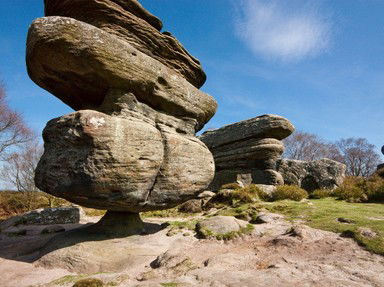Quiz Answer Key and Fun Facts
1. Balancing rocks are quite common. There is even a name for those that rock in the UK. What person's name is also a name for this type of rocking stone?
2. Precariously-balanced boulders have been used on the battlefield. With designs on a direct route to Italy, the Austrian army was routed at the Battle of Morgarten in 1315 in which rocks played their part. In which modern day country is this?
3. Karlu Karlu, also known as the Devils Marbles, is a site of cultural and spiritual significance to the local Aboriginal people. How did the boulders in the photo come to be there?
4. Glacial erratics are sometimes balancing rocks, such as Bubble Rock in Acadia National Park, Maine, US shown in the photo. Which of the following can a glacial erratic help determine?
5. The photo shows Kyaiktiyo Pagoda, a precariously balanced rock which is a well-known pilgrimage site in Myanmar. Which religion is the site important to?
6. Balanced rocks occasionally move. The 2010 biographical drama film "127 Hours" tells of one such occasion, unfortunately trapping Aron Ralston. It cost him his arm. What was he doing?
7. Some boulders are more stable than others with buildings constructed on top, as you can see from the photo. Where are these two monasteries of Meteora to be found?
8. The Adrspach-Teplice area of the Czech Republic is known for its dense zone of sandstone towers. It is a popular climbing area with some unusual restrictions, including not climbing in the rain. True or false?
9. Balancing rocks such as Mother and Child Kopje in Matobo National Park (shown in the image) and some at Chiremba in Epworth, Harare have been appearing on the country's currency since the 1980s. Which country?
10. Balancing rocks are a tourist attraction in most places. What other industry has an interest in them?
Source: Author
suomy
This quiz was reviewed by FunTrivia editor
stedman before going online.
Any errors found in FunTrivia content are routinely corrected through our feedback system.
